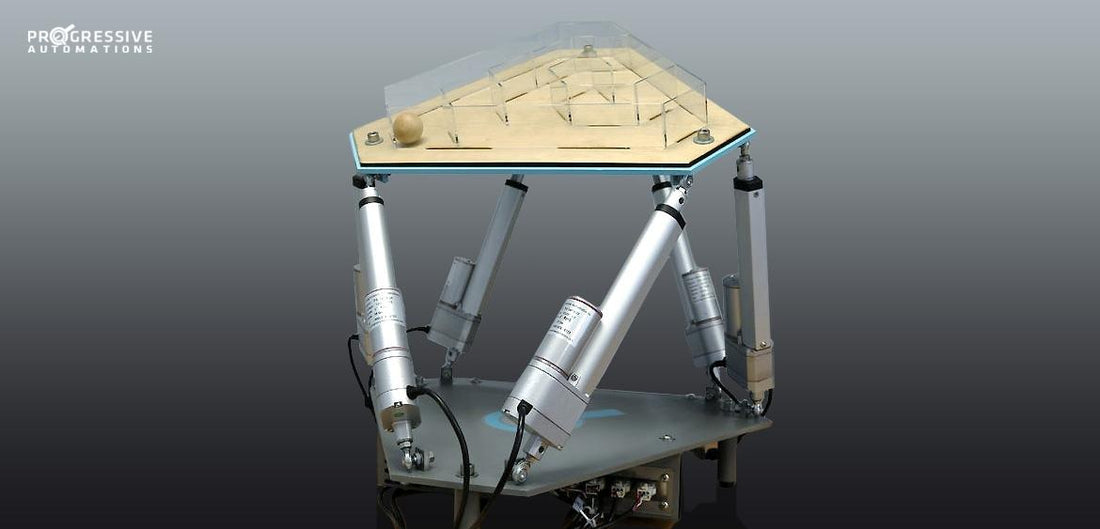Motion simulators are crucial assets for engineering analysis, training, education, and entertainment as they re-create a realistic feeling of things being in motion. Linear actuators are a popular solution for driving mechanical operations due to the significant benefits they can offer; however, motion simulators can integrate them through many different means for a variety of uses. In this article, we will be covering a few examples of motion simulators to better understand how motion simulators and linear actuators work together.
Use Cases
There are many ways to implement electric linear actuators into motion simulators. Just to name a few examples, actuators have been used to drive the linear motion found in:
- Flight simulators
- Military vehicle simulators
- Theme Park rides
- Driving/racing simulators
- Spacecraft simulators
- Stewart Platforms
- Various arcade video games
Six Axis Platform Using Linear Actuators (Stewart Platform)

Proudly sponsored by Progressive Automations, the UBC Engineering Physics department’s Stewart Platform allows for an interesting and interactive experience to learn about linear motion control as well as the physics that is involved in robotics.
By integrating our PA-14P Feedback Linear Actuators, positional information can be read through feedback signals from the actuator’s built-in potentiometers. Having positional information enables a system to determine if the actuators have accurately reached the required positions to minimize errors and allow for higher repeatability. Although devices such as Hall effect sensors and accelerometers could result in higher accuracy, their integration process is more complex while the potentiometer feedback options provided sufficient accuracy with easier integration. Besides that, the PA-14P-6-35 models also happened to offer a speed (2.00"/sec unloaded) and compact size which was suitable for this application that needed a 6” stroke length.

The LC-062 Arduino Due microcontroller interfaces the six actuators alongside two MultiMoto Arduino Shields and to the host PC over a USB serial connection. Since our Multimoto boards could handle a maximum of four independently controlled channels at a time, the six linear actuators required for the project were divided into three per board. The actuator movements were then controlled through a PID feedback system using the PA-14P’s potentiometer readings as inputs.

Along with the custom graphical user interface (GUI), a Leap Motion Controller that uses three IR emitters and two cameras allows the users full motion control of the platform with the wave of their hand. For an in-depth overview of the Stewart Platform, we have included the project report and GitHub links.
https://content.instructables.com/ORIG/FQC/KXUA/JIYU1JDE/FQCKXUAJIYU1JDE.pdf
https://github.com/progressiveautomations/Stewart-Platform
The technology behind Stewart platforms is used in many other modern-day motion simulators due to its 6 degrees of freedom (three for position, three for direction), which is the most degrees of freedom a single rigid body can have. A larger-scale example of this can be seen in the Cruden HexaPod Motion Simulator which uses its six degrees of freedom to allow for the most accurate and repeatable simulations possible.

Flight Simulator using Linear Actuators

As technology continues to advance, motion simulators are gradually becoming more affordable for DIY makers all over the world to experience. A notable example of this can be seen in the Flight Simulator project by our customer Anthony Escalante. With his modular design of custom fabricated components, electronic hardware, and programming, Anthony created a fully functioning Flight Motion Simulator for his home.
Designed with multiple PA-03 and PA-04 Standard Linear Actuators, Anthony’s design boasts 6 Degrees of Freedom, similar to the previously mentioned Stewart Platform. Each of our Standard Linear Actuators had the sufficient speed and force ratings to smoothly handle the tilts, rotations, and turns for simulating true flight through Anothony’s motion platform.

Accompanied by four power supplies, the control system has sufficient current draw to incorporate the motor drivers and microcontrollers which are packed away neatly into the control hub of the simulator.
“It runs really smooth and easy to maintain," said Anthony. "I Ensured it was modular for maintenance. Parts were easily available from hardware stores and metal pieces purchased and cut from Metal Mart. Actuators and suspension are easy to replace. No headache with downtime. My grandmother can even do it herself“.

Track Linear Actuators like the PA-18 and PA-08 are excellent alternatives for indoor motion simulators which required solutions with a compact length when extended and retracted. This is because Track Linear Actuators have a range of motion that is enclosed in a track’s pre-defined path instead of a shaft projecting out into the open air.
Biplane Simulator for Kids

Motion simulators are also used for entertainment purposes such as the Biplane Simulator for Kids by EAA 485. This project was a modernization of the original 3 axis simulator known from a sister chapter in Wetumpka, AL. John McKiernan, the President of EAA 485 happy to share his project to us!
The Biplane Simulator needed a 4” stroke in the roll and pitch axis, and since the yaw axis was on a turntable, moving the attached point could increase or decrease the yaw movement. Having previous experience with our products, McKiernan was able to determine the PA-03 24vdc, 200 lb actuator with a 4” stroke as the suitable model.
“It took less than a day to dial it in and have the yaw axis working. I then purchased 3 more identical actuators to give us a spare. To make the roll and pitch work, it was necessary to machine 4 aluminum blocks to allow a Heim bearing to be installed. The Heim's joints were necessary to take some axial movement in the roll and pitch actuation. These were done by hand and seemed to work just fine. A new fuse panel was later made using normal spade fuses one for each actuator, Hobbs meter, and cockpit. The cockpit has real aircraft gages and a very clever radial engine sound controlled via a throttle. It uses radio control servo testers hooked to a module and a small center speaker behind the instrument panel. It even had a realistic machine gun sound when a button’s pressed,” explains McKiernan.
McKiernan further explains, “The original switches used a spring roller that when the stick or pedals were in neutral was in a phenolic block and moving the stick, or rudder pedals moved it to an aluminum switch plate. I didn’t care for having the stick providing the electrical path although phenolic blocks did isolate the area to under the seat. These were attached to an aluminum plate inverted and adapted each over the existing lower original switch structure.”
The ball rests in the middle position of the switch at neutral and with a stick or pedal movement moves the roller and depresses the switch. The roll system originally round took a bit more tweaking since the actual block had to be sliced to adapt the switch to the base. Despite a few challenges, the Biplane Simulator flew 36 kids on its first outing at the KJKA AOPA and Mckiernan was very pleased with the outcome.
Projects such as these which uses switches as the controls are simpler to integrate for beginners with no programming required. Our Micro Actuators offer a compact size that is perfect for making prototypes or miniature replicas of similar motion simulators. Having a proof of concept for demonstrating in presentations can help uncover certain obstacles the project may encounter before tackling the full-sized motion simulator.
IN SUMMARY
Motion simulators come in a variety of different shapes and sizes that makes them suitable to simulate various applications specific scenarios. Devices such as microcontrollers, switches, and motor drivers are commonly integrated with linear actuators to allow motion simulators to re-enacting motion as accurately as possible.
We hope you found this as informative and interesting as we did, especially if you were interested in how motion simulators and linear actuators work together! If you have any queries or wish to discuss our products further, please do not hesitate in reaching out to us! We are experts in what we do and will be happy to assist in any way we can.
sales@progressiveautomations.com | 1-800-676-6123




